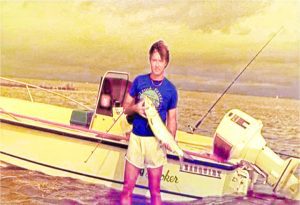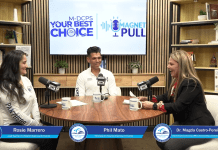|
Getting your Trinity Audio player ready...
|

“See the lily pads jiggle,” my dad whispered as I prepared to cast my Dalton Special topwater lure towards the shoreline. “The largemouth black bass give themselves away, making it a lot easier to catch them.” I quickly reeled in the lure and recast it as close to the stirring lily pads as possible, letting it rest.
Seconds later, a quick jerk of the fishing rod gave the lure life and “wham.” Both Dalton Special and black bass were airborne, and the fight was on.
“You need to free the bass from the Lilly pads, or you’ll get snagged,” Dad said.
After a tug-of-war, I coaxed the bass next to the boat and “whoosh,” Dad swiftly netted a six-pound lunker.
From as far back as 1949, my dad and I fished for large mouth black bass not only on Gainesville lakes but eventually the Everglades, when our family moved to Miami.
Just like Lake Alice, fishing for black bass in the River of Grass was equally fruitful, especially due to its immense size. In fact, it would take a lifetime to fish the Everglades, measuring 7,800 square miles along the southern portion of Florida, featuring Lake Okeechobee.
We fished Everglades fishing spots along the Tamiami Trail Canal teaming with black bass and regrettably the dreaded mudfish, a prehistoric-looking trash fish that fights just like black bass but is inedible, tasting like its namesake.
I’ve spent a lifetime fishing mostly in Florida, but also Georgia, California, Mississippi and New Hampshire. And I’m not limited to freshwater. Living in Miami, I fished in saltwater, including Biscayne Bay, the Florida Keys and the Atlantic Ocean on the East Coast and Sanibel Island on the West Coast.
This story covers my fishing experiences over the past 75 years, from bass fishing with Dad to bonefish fishing in Biscayne Bay, to sailfish and Dolphin fishing in the Atlantic Ocean and more.
Even though I fished the Everglades, my angling life was primarily Biscayne Bay and my favorite quarry was the snook, the saltwater variety of freshwater black bass.
My favorite snook hotspot was at the mouth of the Coral Gables Waterway that empties into Biscayne Bay. The best time to fish for the species was during the winter mullet run, watching them exploding into the air. I used a treble hook to snag mullet and cast it into the feeding melee. Within seconds, a powerful tug on my line meant a hungry snook just engulfed the mullet and the fight was on.
The only downside with wading was periodically being bumped by a manatee once in a blue moon. Better a manatee than a shark.
In addition to snook, my favorite Biscayne Bay quarry is the allusive permit that is virtually impossible to spot since it rarely pauses while feeding. In short, catching one is a total accident; you never fish for permit, they suddenly just show up. When permit feed, they dip their head into the sand to find shrimp and other sea shellfish and in doing so, flip their tails high in the air. The problem is spotting them feeding and quickly closing in for a cast before they swim to deep water.
Bonefish also give themselves away with their tail waving in the air while searching for food, in no hurry to depart from the sand flat. And much like the permit, bonefish would virtually strip the fishing line from my reel in seconds.
A consummate fisherman all my life, I have always dreamed of living on water. In 1993, following the Hurricane Andrew disaster, my family and I decided it was time to move. We saw several houses of interest and finally bought a home in the Village of Pinecrest. As we entered the house for the first time, I immediately noticed in the backyard a freshwater canal. “Sold!”
Every day, I walk along the canal looking for peacock and black bass patrolling for a meal. Not to forget bluegill, catfish, ducks, squirrels and ibis. Never does a day pass when you can find me down at the canal banks enjoying a variety of wildlife. Home sweet home!
It’s an early Miami morning as I step into the warm summer waters of Biscayne Bay. I’m slowly wading to catch my favorite quarry, bonefish and permit. I’m in an incoming tide at my favorite sand flat near Crandon Park Marina, knowing that I will have about an hour before the water gets too deep.
I’m looking for a tailing fish as it rummages for crabs, shrimp, sea worms and sea snails. I notice a flash several hundred yards ahead, the sun reflecting on a silvery fish.
I’m now within casting range and slide a shrimp onto my fishhook. I watch carefully to make sure we don’t cross paths; how many times have I missed a chance with this skittish fish, losing track of its course. Once the bonie notices something not quite right, it hits booster speed.
I’m now wading parallel to the fish, getting closer to cast the shrimp in front of it. The bonie will smell the shrimp and swim to it. If I cannot see the fish, I watch my line begin paying out. The line begins to tighten so it’s time to set the hook.
Then all hell breaks loose! The initial run is unreal as my line quickly disappears from the spinning reel. With very little line left, I wade towards the fish. All that remains is slowly reeling the bonie to my landing net. I unhook and let it swim away to regain its strength. I wade back towards the shoreline, savoring an extraordinary moment in my fishing life that I will never forget. And the episode is as clear to me as it happened 40 years ago. I’m so blessed.
ABOUT US:
For more Miami community news, look no further than Miami Community Newspapers. This Miami online group of newspapers covers a variety of topics about the local community and beyond. Miami’s Community Newspapers offers daily news, online resources, podcasts and other multimedia content to keep readers informed. With topics ranging from local news to community events, Miami’s Community Newspapers is the ideal source for staying up to date with the latest news and happenings in the area.
This family-owned media company publishes more than a dozen neighborhood publications, magazines, special sections on their websites, newsletters, as well as distributing them in print throughout Miami Dade County from Aventura, Sunny Isles Beach, Miami Beach, Coral Gables, Brickell, Coconut Grove, Pinecrest, South Miami, Kendall, Palmetto Bay, Cutler Bay and Homestead. Each online publication and print editions provide comprehensive coverage of local news, events, business updates, lifestyle features, and local initiatives within its respective community.
Additionally, the newspaper has exclusive Miami community podcasts, providing listeners with an in-depth look into Miami’s culture. Whether you’re looking for local Miami news, or podcasts, Miami’s Community Newspapers has you covered. For more information, be sure to check out: https://communitynewspapers.com.
If you have any questions, feel free to email Michael@communitynewspapers.com or Grant@communitynewspapers.com.





